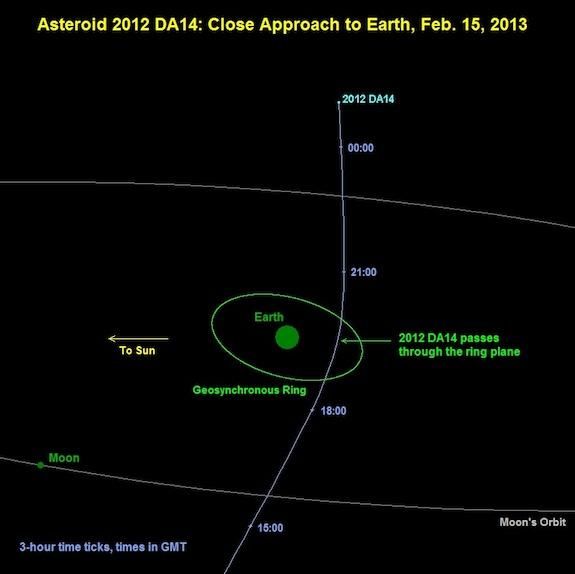An Asteroid Will Skim Right By the Earth on Friday Afternoon
The 147-foot-wide rock will pass a scant 17,200 miles from Earth’s surface, under the orbits of some telecom satellites
/https://tf-cmsv2-smithsonianmag-media.s3.amazonaws.com/filer/Surprising-Science-Asteroid-631.jpg)
This Friday afternoon at approximately 2:26 Eastern time, an asteroid roughly half the size of a football field (147 feet) in diameter will pass extremely close to the Earth—just 17,200 miles from our planet’s surface. That said, there’s no need to worry, as NASA scientists confirmed with certainty nearly a year ago that the asteroid will not make an impact and poses absolutely no threat.
Nevertheless, the proximity of the asteroid’s path is noteworthy: it will come within a distance 2 times the Earth’s diameter, passing us by even closer than some geosynchronous satellites that broadcast TV, weather and radio signals. As Phil Plait writes in his comprehensive post on the asteroid over at Slate, “This near miss of an asteroid is simply cool. It’s a big Universe out there, and the Earth is a teeny tiny target.”

The asteroid—likely made of rock and referred to as 2012 DA14 by scientists—was first spotted last February by astronomers at Spain’s Observatorio Astronómico de La Sagra. Asteroids, like planets, orbit the Sun, and this one passed us by on its last orbit as well, but at a much greater distance—it came within roughly 1.6 million miles last February 16. After this year’s near miss, the rock’s orbit will be altered significantly by the influence of Earth’s gravity, and scientists calculate that it won’t come near us again until the year 2046 at the soonest.
On Friday, though, it will pass by Earth between 18:00 and 21:00 UTC (1-4 p.m. Eastern time, or 10 a.m.-1 p.m. Pacific) and come closest at roughly 19:26 UTC (2:26 p.m. Eastern, 11:26 a.m. Pacific). That means that observers in Eastern Europe, Asia and Australia get to see its closest pass at nighttime, whereas those in North America, Western Europe and Africa will have to wait until after sunset, when the asteroid has already begun to move away.
For all observers, the asteroid will be too small to see with the naked eye, though it should be viewable with binoculars or a telescope. Universe Today has the technical details on where exactly to spot the asteroid in the sky. A number of observatories and organizations will also broadcast video streams of the asteroid live, including NASA.
A fly-by like the one on Friday isn’t particularly rare in terms of mere proximity. There are seven closer asteroid passes on record—in 2011, a tiny asteroid set the record for near misses by coming within 3300 miles of Earth, and in 2008, an even smaller one actually made contact with the atmosphere, burning up over Africa.
Both of those rocks, though, were less a meter across.What distinguishes this asteroid is that it’s passing close by and theoretically large enough to cause major damage if an impact were to occur. While an asteroid of this size passes this closely roughly every 40 years on average, a collision with an object this size only happens once every thousand years or so.
What kind of damage would that impact wreak? For a comparison, many are noting the Tunguska event, an explosion over a remote area Russia in 1908 that was likely caused by an asteroid of similar size burning up in the atmosphere. The explosion knocked down more than 80 million trees covering an area of some 830 square miles; scientists estimate it released more than 1,000 times as much energy as the nuclear bomb dropped on Hiroshima and triggered shock waves that would have registered a 5.0 on the Richter scale.
Of course, unlike in 1908, we now have the power to observe approaching asteroids well ahead of time—and might have the ability to prevent potential collisions. Bill Nye is among those who argue that this event should serve as a wake-up call for the importance of investing in asteroid-detecting infrastructure, such as observatories and orbiting telescopes. The B612 Foundation supports this mission, and advocates for the development of technologies that could slightly alter the path or speed of an approaching object to avoid an impact.
This time, at least, we’re lucky. But Ed Lu, a former astronaut and head of B612, says this event should not be taken lightly. ”It’s a warning shot across our bow,” he told NPR. “We are flying around the solar system in a shooting gallery.”
/https://tf-cmsv2-smithsonianmag-media.s3.amazonaws.com/accounts/headshot/joseph-stromberg-240.jpg)
/https://tf-cmsv2-smithsonianmag-media.s3.amazonaws.com/accounts/headshot/joseph-stromberg-240.jpg)